
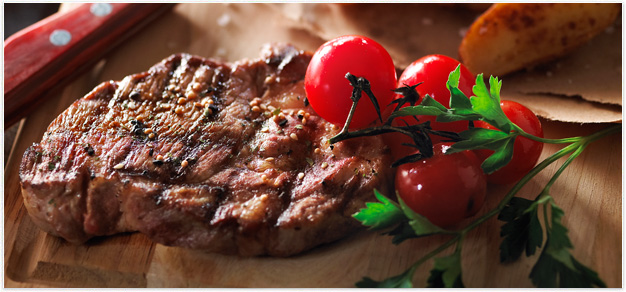

False Lean
An interesting underutilized cut is the false lean, a subcutaneous muscle imbedded in the fat overlying the shoulder end of the loin. Also known as the “small deckle” or “rib cap” the name false lean comes from its misleading location on the loin and the fact that it is not attached to the main loin muscle complex. Many commercial boneless loin specifications require the removal of the false lean and often this specialty cut ends up in loin trimmings 60 – 65% lean.
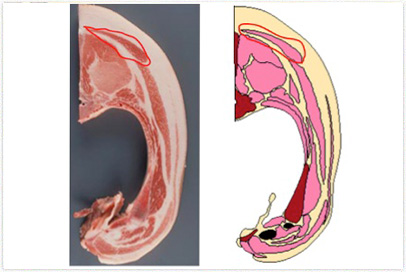
Cross cut carcass middle image showing false lean location (Image source: porcine.uni.edu/)
I was first introduced to this cut in the early eighties while working in a small German-style butcher shop in Edmonton, Alberta. Regular patrons would come in on the days we were manufacturing Canadian style back bacon and request the trimmed “Rib Cap Piece” as a grilling steak. Customers told me the steak has the tenderness of the fillet but with much more flavour. Many years later I was re-introduced to the cut by Japanese foodservice customers requesting the same specification for Yakiniku (Japanese style barbecue). An innovative French chef refers to this cut as the “calotte” and it’s often served at room temperature as a quickly seared Carpaccio. According to Chef, when sliced and served, the calotte “almost melts in your mouth.”
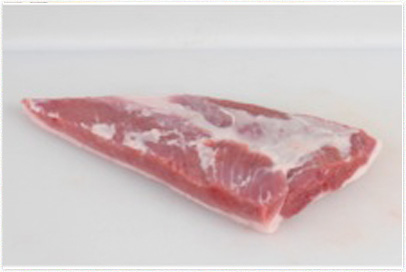
False lean as removed from the boneless loin
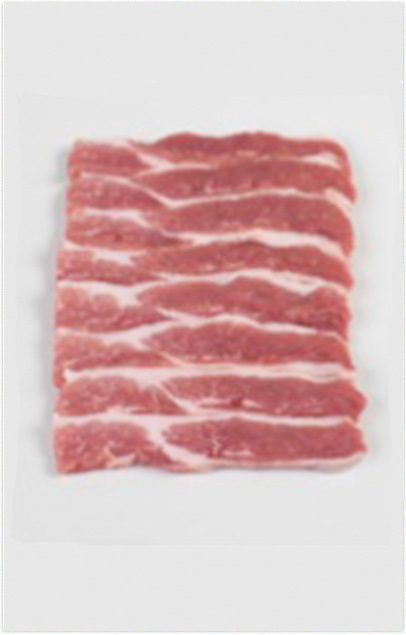
False lean sliced for Yakiniku (Japanese style barbecue) 5 mm thick
The false lean piece weighs 750 g to 1.5 kg (depending on loin size, the carcass break at the shoulder-end and trim specifications) and is approximately 3 – 4 cm thick at the highest point. This specialty item is typically portion-cut into grilling steaks approximately 142 g or thinly sliced 2 – 3 mm for stir-frying or hot pot, 5 – 7 mm for Yakiniku (Japanese style barbecue). Steaks are typically grilled like a beef flank or flat iron steak. Once the steak has been grilled to preferred doneness it can be carved across the grain by a straight cut or at a 45-degree angle depending on the application. This cut tends to appear darker red in colour than the rest of the loin muscles and is very dark when cooked, almost resembling beef. It is often served medium rare in order to fully enjoy the marbling and intense flavour.
In my opinion, pork deckle steaks (as they are referred to on some menus) may be the most affordable luxury meal you’ll ever grill for yourself, family and friends. This cut has a delicious, rich-flavoured exterior combined with finely marbled muscle characteristics throughout, delivering juicy intense flavour.
False lean is virtually unheard of in North American markets. It represents an excellent opportunity to maximize profit potential, value and interest to the pork product mix in both the retail and foodservice segments. False lean is included on the new Canadian Pork Buyers Guide Chart: Loin, Rib Cap (false lean) CPI product code # C229 and featured as a sliced product on the Canadian Pork Retail and Foodservice End-User component of the chart as well. The cut will also be included in the second edition of the Canadian Pork Handbook due to be released in 2015. Canadian Pork Buyers Guide brochure is available from CPI as a printed resource or a digital version. The wall chart version will be printed in the coming months and available to all CPI members and stakeholders.
Technical Information
Source: Porcine Myology (www.porcine.uni.edu/)
| Muscle Name: Trapezius |
| Group: Dorsal |
| Insertion: Spine of scapula |
| Innervation: Accessory (11th cranial) nerve |
| Blood Supply: Dorsal, deep cervical and Intercostal arteries |
| Origin: Occipital bone thru the tenth thoracic vertebrae |
| Common Industrial Names: False Lean, Small Deckle Muscle, Rib Cap, Deckle Steak, Butter Steak |
For more information about this cut or suggestions for future items to be profiled please contact Michael Young, Director, Technical Programs and Marketing Services T.778.425.1982 young@canadapork.com
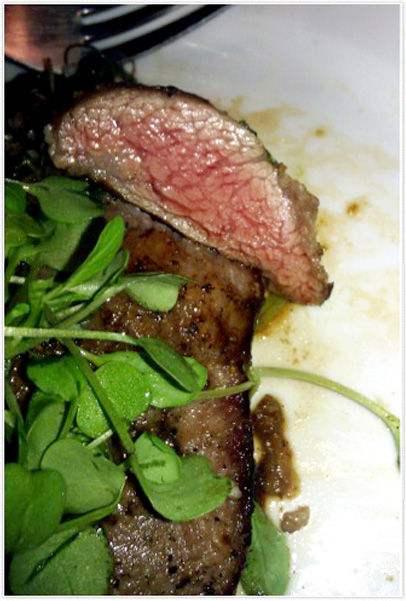
Pork Deckle Steal: Grilled to perfection
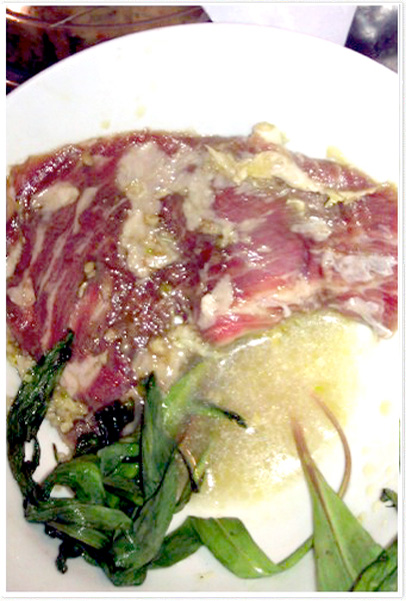
Pork Deckle Steak: Marinated in Vermouth, Garlic, Pepper, and Salt
Back to main page ›
|
You’re receiving this newsletter because you’ve subscribed to the CPI in Action. Not interested anymore? If you have any comments regarding this newsletter please do not hesitate to contact our editor at editor@newsletter.ca |
Canada Pork International 220 Laurier Avenue West, Suite 900 Ottawa, Ontario, Canada K1P 5Z9 www.canadapork.com T +613 236 9886 F +613 236 6658 E cpi@canadapork.com |